httpv://youtu.be/fhMldvW3Sbo
Sri Caitanya-caritamrta: Adi-lila
TEXT 61
radhadese janmila thakura nityananda
gangadasa pandita, gupta murari, mukunda
SYNONYMS
radha-dese—the place where there is no Ganges; janmila—took birth; thakura nityananda—Nityananda Prabhu; gangadasa pandita—of the name Gangadasa Pandita; gupta murari—of the name Murari Gupta; mukunda—of the name Mukunda.
TRANSLATION
In Radhadesa, the part of Bengal where the Ganges is not visible, Nityananda Prabhu, Gangadasa Pandita, Murari Gupta and Mukunda took birth.
PURPORT
Here radha-dese refers to the village of the name Ekacakra in the district of Birbhum, next to Burdwan. After the Burdwan railway station there is another branch line, which is called the Loop Line of the eastern railway, and there is a railway station of the name Mallarapura.
Eight miles east of this railway station Ekacakra Village is still situated. Ekacakra Village extends north and south for an area of about eight miles. Other villages, namely Viracandra-pura and Virabhadra-pura, are situated within the area of the village of Ekacakra. In honor of the holy name of Virabhadra Gosvami, these places are renowned as Viracandra-pura and Virabhadra-pura.
In the Bengali year 1331 (A.D. 1924) a thunderbolt struck the temple of Ekacakra-grama. Therefore the temple is now in a broken state. Before this, there were no such accidents in that quarter. Within the temple there is a Deity of Sri Krishna established by Sri Nityananda Prabhu. The name of the Deity is Bankima Raya or Banka Raya.
On the right side of Bankima Raya is a Deity of Jahnava, and on His left side is Srimati Radharani. The priests of the temple describe that Lord Nityananda Prabhu entered within the body of Bankima Raya and that the Deity of Jahnava-mata was therefore later placed on the right side of Bankima Raya.
Afterwards, many other Deities were installed within the temple. On another throne within the temple are Deities of Muralidhara and Radha-Madhava. On another throne are Deities of Manomohana, Vrindavana-candra and Gaura-Nitai. But Bankima Raya is the Deity originally installed by Nityananda Prabhu.
On the eastern side of the temple is a ghata known as Kadamba-khandi on the bank of the Yamuna, and it is said that the Deity of Bankima Raya was floating in the water and Lord Nityananda Prabhu picked Him up and then installed Him in the temple.
Thereafter, in a place known as Bhaddapura, in the village of Viracandra-pura, about half a mile west, in a place underneath a nima tree, Srimati Radharani was found. For this reason, the Radharani of Bankima Raya was known as Bhaddapurera Thakurani, the mistress of Bhaddapura. On another throne, on the right side of Bankima Raya, is a Deity of Yogamaya.
Now the temple and temple corridor rest on a high plinth, and on a concrete structure in front of the temple is a meeting hall. It is also said that on the northern side of the temple there was a Deity of Lord Siva named Bhandisvara and that the father of Nityananda Prabhu, Hadai Pandita, used to worship that Deity.
At present, however, the Bhandisvara Deity is missing, and in his place a Jagannatha Svami Deity has been installed. Lord Nityananda Prabhu did not factually construct any temples. The temple was constructed at the time of Virabhadra Prabhu. In the Bengali year 1298 (A.D. 1891), the temple being in a dilapidated condition, a brahmacari of the name Sivananda Svami repaired it.
In this temple there is an arrangement to offer foodstuffs to the Deity on the basis of seventeen seers of rice and necessary vegetables. The present priestly order of the temple belongs to the family of Gopijana-vallabhananda, one of the branches of Nityananda Prabhu.
There is a land settlement in the name of the temple, and income from this land finances the expenditures for the temple. There are three parties of priestly gosvamis who take charge of the temple management, one after another. A few steps onward from the temple is a place known as Visramatala, where it is said that Nityananda Prabhu in His childhood used to enjoy sporting with His boyfriends by enacting the rasa-lila and various other pastimes of Vrindavana.
Near the temple is a place named Amalitala, which is so named because of a big tamarind tree there. According to a party named the Nedadi-sampradaya, Virabhadra Prabhu, with the assistance of twelve hundred Nedas, dug a great lake of the name Svetaganga. Outside of the temple are tombs of the Gosvamis, and there is a small river known as the Maudesvara, which is called the water of Yamuna.
Within half a mile from this small river is the birthplace of Sri Nityananda Prabhu. It appears that there was a big meeting hall in front of the temple, but later it became dilapidated. It is now covered by banyan trees. Later on, a temple was constructed within which Gaura-Nityananda Deities are existing.
The temple was constructed by the late Prasannakumara Karapharma. A tablet was installed in his memory in the Bengali year 1323 (A.D. 1916), in the month of Vaisakha (April-May).
The place where Nityananda Prabhu appeared is called Garbhavasa. There is an allotment of about forty-three bighas (fourteen acres) of land to continue the worship in a temple there. The Maharaja of Dinajapura donated twenty bighas (6.5 acres) of land in this connection. It is said that near the place known as Garbhavasa, Hadai Pandita conducted a primary school.
The priests of this place, listed in a genealogical table, were as follows: (1) Sri Raghavacandra, (2) Jagadananda dasa, (3) Krishnadasa, (4) Nityananda dasa, (5) Ramadasa, (6) Vrajamohana dasa, (7) Kanai dasa, (8) Gauradasa, (9) Sivananda dasa and (10) Haridasa. Krishnadasa belonged to the Cidiya-kusja at Vrindavana.
The date of his disappearance is Krishna-janmastami. Cidiya-kusja is a place now managed by the gosvamis of Singara-ghata in Vrindavana. They are also known as belonging to the Nityananda family, most probably on the basis of their relationship with Krishnadasa.
Near Garbhavasa is a place called Bakulatala, where Sri Nityananda Prabhu and His boyfriends used to take part in sporting activities known as jhala-jhapeta.
There is a bakula tree there that is wonderful because all its branches and subbranches look like the hoods of serpents. It has been suggested that by the desire of Sri Nityananda Prabhu, Anantadeva manifested Himself in that way.
The tree is very old. It is said that formerly it had two trunks, but later on, when the playmates of Nityananda Prabhu felt inconvenience in jumping from the branches of one trunk to those of the nother, Nityananda Prabhu, by His mercy, merged the two trunksinto one.
Another place nearby is named Hantugada. It is said that Lord Nityananda Prabhu brought all the holy places there. Therefore the people in the surrounding villages go there instead of to the Ganges to take bath. It is named Hantugada because Srila Nityananda Prabhu used to perform the dadhi-cida festival of distributing chipped rice with yogurt prasada there and He took the prasada kneeling down.
A sanctified lake in this place is always full of water throughout the year. A great fair is held there during Gosthastami, and there is another big fair on the birthday of Sri Nityananda Prabhu. In the Gaura-ganoddesa-dipika it is described that Halayudha, Baladeva, Visvarupa and Sankarsana appeared as Nityananda Avadhuta
Books : Sri Caitanya-caritamrta – 1975 Edition : Cc. Adi-lila : Adi 13: The Advent of Lord Sri Caitanya Mahaprabhu : Adi 13.61 : PURPORT
tabe nityananda-svarupera agamana
prabhuke miliya paila sad-bhuja-darsana
SYNONYMS
tabe—thereafter; nityananda-svarupera—of the Personality of Godhead Nityananda; agamana—appearance; prabhuke—Lord Caitanya Mahaprabhu; miliya—meeting; paila—obtained; sat-bhuja-darsana—a vision of the six-armed Sri Caitanya Mahaprabhu.
TRANSLATION
After this function at the house of Srivasa Thakura, Nityananda Prabhu appeared, and when He met with Lord Caitanya He got the opportunity to see Him in His six-armed form.
PURPORT
The form of Sad-bhuja, the six-armed Lord Gaurasundara, is a representation of three incarnations. The form of Sri Ramacandra is symbolized by a bow and arrow, the form of Lord Sri Krishna is symbolized by a stick and flute like those generally held by a cowherd boy, and Lord Caitanya Mahaprabhu is symbolized by a sannyasa-danda and kamandalu, or waterpot.
Srila Nityananda Prabhu was born in the village of Ekacakra in the district of Birbhum as the son of Padmavati and Hadai Pandita. In His childhood He played like Balarama. When He was growing up, a sannyasi came to the house of Hadai Pandita, begging to have the pandita’s son as his brahmacari assistant.
Hadai Pandita immediately agreed and delivered his son to him, although the separation was greatly shocking, so much so that Hadai lost his life after the separation. Nityananda Prabhu traveled on many pilgrimages with the sannyasi.
It is said that for many days He lived at Mathura with him, and at that time He heard about Lord Caitanya Mahaprabhu’s pastimes in Navadvipa.
Therefore He came down to Bengal to see the Lord. When Lord Nityananda came to Navadvipa, He was a guest at the house of Nandana Acarya. Understanding that Nityananda Prabhu had arrived, Lord Caitanya sent His devotees to Him, and thus there was a meeting between Sri Caitanya Mahaprabhu and Nityananda Prabhu.
Books : Sri Caitanya-caritamrta – 1975 Edition : Cc. Adi-lila : Adi 17: The Pastimes of Lord Caitanya Mahaprabhu in His Youth : Adi 17.12 : PURPORT
sri-krsna-caitanya ara prabhu nityananda
yanhara prakase sarva jagat ananda
The appearance of Sri Krishna Caitanya and Prabhu Nityananda has surcharged the world with happiness
Sri Caitanya-caritamrta – 1975 Unrevised Edition : Cc. Adi-lila : Adi 1: The Spiritual Masters : Adi 1.87
ei candra surya dui parama sadaya
jagatera bhagye gaude karila udaya
These two, the sun and moon, are very kind to the people of the world. Thus for the good fortune of all, They have appeared on the horizon of Bengal
The celebrated ancient capital of the Sena dynasty, which was known as Gaudadesa or Gauda, was situated in what is now the modern district of Maldah. Later this capital was transferred to the ninth or central island on the western side of the Ganges at Navadvipa, which is now known as Mayapur and was then called Gaudapura.
Lord Caitanya appeared there, and Lord Nityananda came there and joined Him from the district of Birbhum. They appeared on the horizon of Gaudadesa to spread the science of Krishna consciousness, and it is predicted that as the sun and moon gradually move west, the movement They began five hundred years ago will come to the Western civilizations by Their mercy.
Caitanya Mahaprabhu and Nityananda Prabhu drive away the five kinds of ignorance of the conditioned souls. In the Mahabharata, Udyoga-parva, Forty-third Chapter, these five kinds of ignorance are described.
They are (1) accepting the body to be the self, (2) making material sense gratification one’s standard of enjoyment, (3) being anxious due to material identification, (4) lamenting and (5) thinking that there is anything beyond the Absolute Truth.
The teachings of Lord Caitanya eradicate these five kinds of ignorance. Whatever one sees or otherwise experiences one should know to be simply an exhibition of the Supreme Personality of Godhead’s energy. Everything is a manifestation of Krishna.
Sri Caitanya-caritamrta – 1975 Edition : Cc. Adi-lila : Adi 1: The Spiritual Masters : Adi 1.102 :
advaita, nityananda–caitanyera dui anga
angera avayava-gana kahiye upanga
Sri Advaita Prabhu and Sri Nityananda Prabhu are both plenary portions of Lord Caitanya. Thus They are the limbs [angas] of His body. The parts of these two limbs are called the upanga
Cc. Adi-lila : Adi 3: The External Reasons for Lord Caitanya’s Appearance : Adi 3.72
jaya jaya nityananda-caranaravinda
yanha haite painu sri-radha-govinda
All glory, all glory to the lotus feet of Lord Nityananda, by whose mercy I have attained Sri Radha-Govinda
Srila Narottama dasa Thakura, who is famous for his poetic composition known as Prarthana, has lamented in one of his prayers, “When will Lord Nityananda be merciful upon me so that I will forget all material desires?”
Srila Narottama dasa Thakura confirms that unless one is freed from material desires to satisfy the needs of the body and senses, one cannot understand the transcendental abode of Lord Krishna, Vrindavana. He also confirms that one cannot understand the loving affairs of Radha and Krishna without going through the direction of the six Gosvamis.
In another verse Narottama dasa Thakura has stated that without the causeless mercy of Nityananda Prabhu, one cannot enter into the affairs of Radha and Krishna.
Sri Caitanya-caritamrta – 1975 Edition : Cc. Adi-lila : Adi 5: The Glories of Lord Nityananda Balarama : Adi 5.204


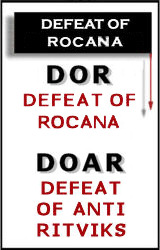
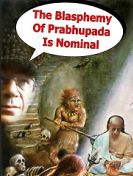
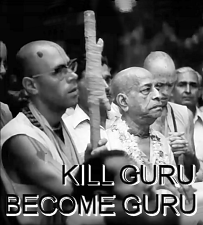
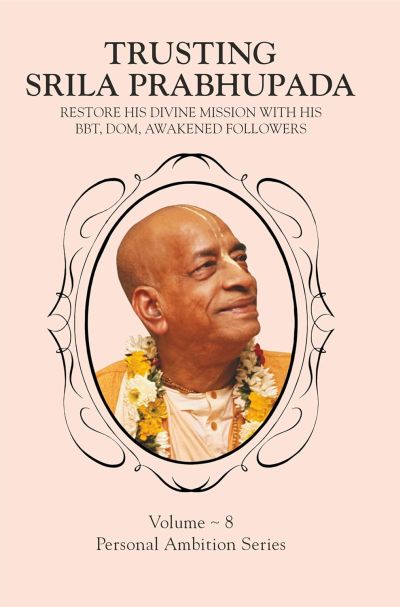
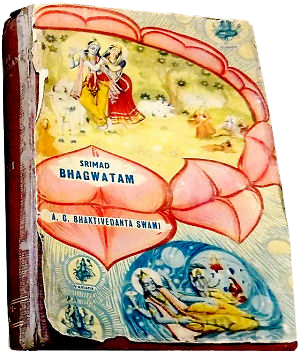
Speak Your Mind